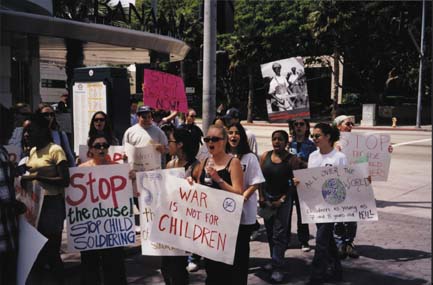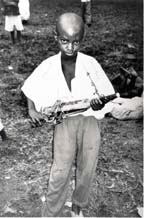International tragedy of child soldiers must stop
When Sarah, 17, heard kids were forced to fight in wars, she had to take action.
Turn on the TV and what do you see? Every channel flashes stories about Elian Gonzalez, JonBenet Ramsey and other cute little kids in trouble. But you never hear about a much greater tragedy—the problem of child soldiers. In countries as far away as Peru and Somalia, rebel groups and government armies kidnap 300,000 children each year from their homes and force them to become soldiers.
Boia Efraime, an activist from Mozambique, came to speak at my school about this problem in January. A child psychologist and former teacher, he explained how children make ideal soldiers. Armies can easily inject their doctrines of hate into children’s inexperienced and vulnerable minds. Cowed by drugs and beatings, they will follow their commanders’ orders despite the danger or cruelty involved. When Boia told us how a rebel group recruited a boy he had worked with, we students gasped.
"A group of men burst into the boy’s home, grabbed the boy and his father, and forced a knife into the child’s hand. One of these men ordered the boy to stab his own father to death. When the boy refused, the father told his son, ‘Do it, so at least you can have a chance to live.’"
Boia had heard many children tell stories like these. "A child’s first victims are often the ones closest to him. These commanders know that villages will never welcome back someone who commits atrocity against his own people."
After meeting with Boia, my friends and I talked angrily. How crazy it seemed that 300,000 people our age and younger were forced to fight! As we learned more about the emotional and sexual violence child soldiers suffer, the lack of international concern about their abuse disturbed us just as much. For example, we soon learned that the U.S. had refused to sign a United Nations treaty that would ban the use of children under 18 as soldiers. Because 0.5 percent of our own army includes 17-year-olds, the Pentagon insisted on modifying this treaty called the Optional Protocol to the Convention on the Rights of the Child. We are still waiting for Congress to open a debate on this treaty, much less ratify or pass it.
Why don’t powerful Americans like senators and church leaders lead the protest against the use of child soldiers, we wondered. Although children fight in Europe and Asia, they suffer the worst abuse in Africa. It hurts to accuse Americans of racism, but we care much more about people who look like ourselves than people with dark skin and different facial features. We do our best to end tragedies in Europe, like the slaughter of thousands in Kosovo, but keep quiet when it comes to Africa. Six years ago, the U.S. government did nothing to stop the genocide of a million people in Rwanda. Today, no one is acting to stop the child soldiers—so we decided to do something.
We started small
A dozen of us seniors and juniors started to devote time during lunch and after school to Human Rights Watch, the organization that sponsored Boia’s visit. We knew that Boia had created Rebuilding Hope, a community that would welcome escaped child soldiers back into ordinary life, so we started to raise funds for this program. We created green ribbons that a student could pin to her sweater to support the treaty to ban child soldiers. In one week, we had a shoebox stuffed with 300 dollars.
Our small group at Immaculate Heart began to meet with students from high schools as diverse as Manual Arts, Crenshaw and Palisades. In February, teens from Manual Arts—and a student activist who came down from San Francisco to attend—joined Human Rights Watch representatives to tell our whole school about the problem of child soldiers. Within a few weeks, we had gained immense help from our student body; we had new volunteers, $300 more from ribbon sales and 500 signed postcards urging our senators to support the Optional Protocol that would ban the use of child soldiers. Then we planned a march.
"Hey, what are you doing this Saturday? Can you go to the child soldier march? It’s down in Santa Monica, I can give you a ride." Pleas to friends, announcements during club meetings, even offers of extra credit from history teachers—all these encouraged almost 100 students at my school to sign up for the march. At both Palisades and Immaculate Heart, students stayed after school to create piles of posters proclaiming "War is not for Children!" and "Ratify the Protocol!" Three seniors even designed and silk-screened hundreds of T-shirts for marchers to buy and wear.
On Saturday morning, by the time we gathered to hear a speech and start our march, between 200 and 300 people had arrived, some adults but mostly students. They were from junior high to college age, wearing everything from mohawks to surfer shorts to Birkenstocks.

Sarah joined more than 200 people who marched in Santa Monica to protest the use of child soliders worldwide.
As we walked past the stores of the Promenade, our shouts of "No child soldiers!" and "War is not for children!" grabbed the attention of all the shoppers, café customers and street vendors. At the information tables we’d set up along the street, other students explained the issue of child soldiers to passersby. After learning about the cause, one bystander joined our march. With shaggy hair flying and green ribbon proudly displayed on his chest, he chanted "No a la guerra! No es para los niños!"
After we finished the two-mile march, students and adults streamed into the parking lot, a bit tired but proud of ourselves. With all our efforts to raise funds and publicize the issue of child soldiers behind us, however, we must keep working so the problem receives enough concern to get solved.
If you want to get involved, contact Human Rights Watch at (213) 680-9906 or see the groups’ Web site at http://www.hrwcalifornia.org.
See also The Coalition to Stop the Use of Child Soldiers http://www.child-soldiers.org





